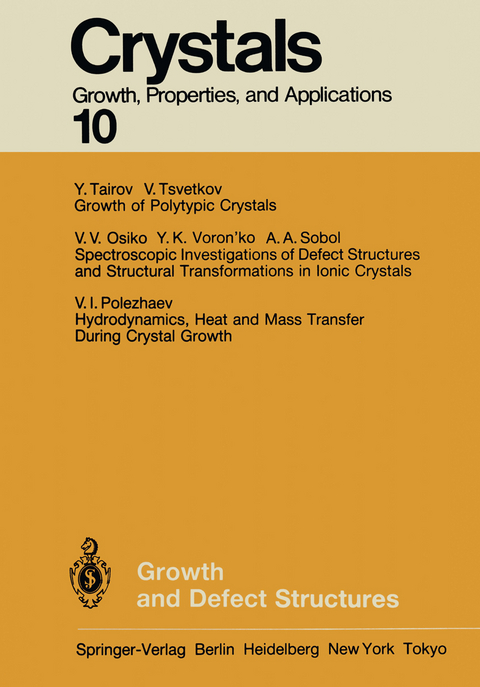
Growth and Defect Structures
Seiten
2011
|
1. Softcover reprint of the original 1st ed. 1984
Springer Berlin (Verlag)
978-3-642-69868-2 (ISBN)
Springer Berlin (Verlag)
978-3-642-69868-2 (ISBN)
With contributions by numerous experts
Polytypic crystals of semiconductors, dielectrics and magnetic materials attract an increasing attention in science and technology. On one hand, the phenomenon of polyty pism is one of the fundamental problems of solid-state physics; its solution would make it possible to elucidate- the problem of the interconnection of different structures and intraatomic forces acting in crystals. On the other hand, the polytypic difference in crystals is most strongly expressed in electro-physical properties, which makes their application promising, mainly in semiconductor electronics. Thus, the difficulties of pro ducing modulated structures in polytypic crystals can be overcome since these crystals form a class of one-dimensional natural superlattices. At present it has become clear that polytypism in crystals and compounds is the rule rather than an exception and it is determined by the conditions of their synthesis. This phenomenon seems to be rather widespread in nature and fundamental for crystal forma tion. H polytypism was recently thought to be but a specific structural feature of a few substances such as SiC, ZnS, CdI , etc. , by now this phenomenon has been discovered in 2 v an increasing range of crystalline substances, for example, in silicon, diamond, AIIIB , VI AIIB , AIBVII compounds, in ternary semiconducting compounds, metals, silicates, perovskites, mica, organic crystals. The more accurately the structural studies are per formed, the greater is the number of crystals of various substances found to exhibit the phenomenon of polytypism. Recently, excellent surveys have systematized our knowledge of polytypism.
Polytypic crystals of semiconductors, dielectrics and magnetic materials attract an increasing attention in science and technology. On one hand, the phenomenon of polyty pism is one of the fundamental problems of solid-state physics; its solution would make it possible to elucidate- the problem of the interconnection of different structures and intraatomic forces acting in crystals. On the other hand, the polytypic difference in crystals is most strongly expressed in electro-physical properties, which makes their application promising, mainly in semiconductor electronics. Thus, the difficulties of pro ducing modulated structures in polytypic crystals can be overcome since these crystals form a class of one-dimensional natural superlattices. At present it has become clear that polytypism in crystals and compounds is the rule rather than an exception and it is determined by the conditions of their synthesis. This phenomenon seems to be rather widespread in nature and fundamental for crystal forma tion. H polytypism was recently thought to be but a specific structural feature of a few substances such as SiC, ZnS, CdI , etc. , by now this phenomenon has been discovered in 2 v an increasing range of crystalline substances, for example, in silicon, diamond, AIIIB , VI AIIB , AIBVII compounds, in ternary semiconducting compounds, metals, silicates, perovskites, mica, organic crystals. The more accurately the structural studies are per formed, the greater is the number of crystals of various substances found to exhibit the phenomenon of polytypism. Recently, excellent surveys have systematized our knowledge of polytypism.
Growth of Polytypic Crystals.- Spectroscopic Investigations of Defect Structures and Structural Transformations in Ionic Crystals.- Hydrodynamics, Heat and Mass Transfer During Crystal Growth.- Author Index Volumes 1-10.
| Erscheint lt. Verlag | 24.11.2011 |
|---|---|
| Reihe/Serie | Crystals |
| Zusatzinfo | VI, 152 p. 4 illus. |
| Verlagsort | Berlin |
| Sprache | englisch |
| Maße | 170 x 244 mm |
| Gewicht | 294 g |
| Themenwelt | Naturwissenschaften ► Chemie ► Anorganische Chemie |
| Naturwissenschaften ► Chemie ► Physikalische Chemie | |
| Naturwissenschaften ► Physik / Astronomie ► Festkörperphysik | |
| Technik ► Maschinenbau | |
| Schlagworte | Crystal Identification • Electronics • growth • spectroscopy • Structures |
| ISBN-10 | 3-642-69868-9 / 3642698689 |
| ISBN-13 | 978-3-642-69868-2 / 9783642698682 |
| Zustand | Neuware |
| Haben Sie eine Frage zum Produkt? |
Mehr entdecken
aus dem Bereich
aus dem Bereich
Buch | Hardcover (2024)
Springer Spektrum (Verlag)
64,99 €


